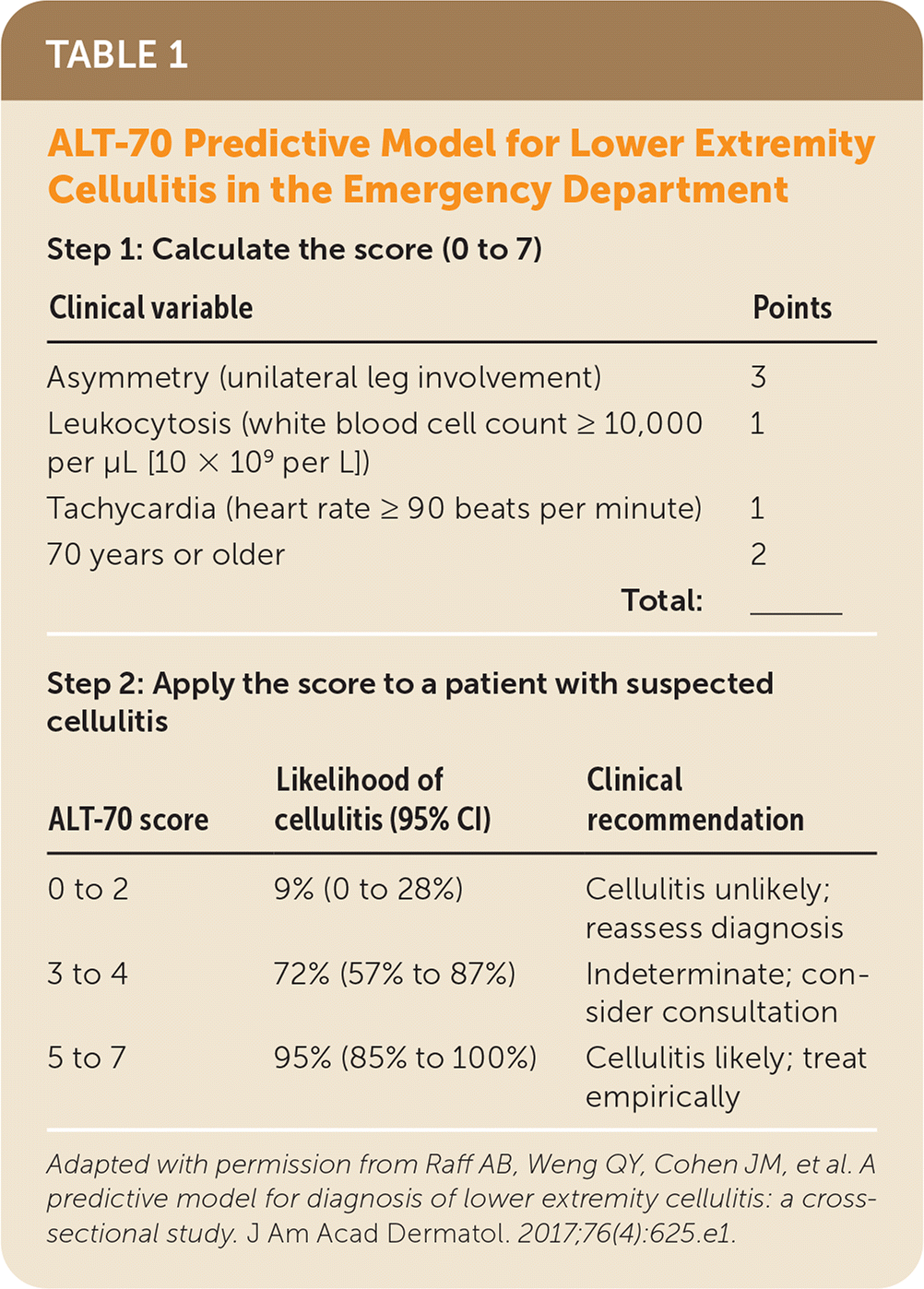
Am Fam Physician. 2021;104(3):309-310
Author disclosure: No relevant financial affiliations.
Clinical Question
How can a clinician best determine whether a patient with lower leg erythema has cellulitis?
Evidence Summary
Lower extremity cellulitis typically presents with acutely expanding erythema, warmth, edema, and tenderness. These signs and symptoms are nonspecific, making it difficult for clinicians to distinguish between true cellulitis and its mimics (pseudocellulitis), many of which do not need treatment with antibiotics. Common mimics include contact dermatitis, venous stasis dermatitis, superficial thrombophlebitis, gout, and lymphedema but can also include more serious mimics such as deep venous thrombosis, necrotizing fasciitis, and septic arthritis. Studies have shown that about 30% of people admitted to the hospital for treatment of cellulitis are mis-diagnosed,1–3 resulting in unnecessary hospitalizations and intravenous antibiotic therapy. Dermatology consultation increases diagnostic accuracy for cellulitis1 and is often used as the criterion standard in cellulitis studies but is not feasible in every patient.
A study of 73 adults diagnosed clinically with cellulitis in the emergency department found that a temperature difference of 0.85°F (0.47°C) or more between affected and corresponding unaffected areas, measured by thermal imaging, was 100% sensitive and 50% specific for cellulitis.2 Thus, thermal imaging had a negative predictive value of 100% but required specialized equipment that is often not available.
The seven-point ALT-70 score for cellulitis (https://www.mdcalc.com/alt-70-score-cellulitis) is a clinical prediction rule developed using a retrospective chart review of 259 patients, of whom 70% had a final diagnosis of cellulitis (Table 1).4 It can be used to help differentiate cellulitis from pseudocellulitis at presentation and had similar predictive value for inpatients at 24 and 48 hours after presentation, based on a retrospective chart review.4,5

| Step 1: Calculate the score (0 to 7) | ||
| Clinical variable | Points | |
| Asymmetry (unilateral leg involvement) | 3 | |
| Leukocytosis (white blood cell count ≥ 10,000 per μL [10 × 109 per L]) | 1 | |
| Tachycardia (heart rate ≥ 90 beats per minute) | 1 | |
| 70 years or older | 2 | |
| Total: ______ | ||
| Step 2: Apply the score to a patient with suspected cellulitis | ||
| ALT-70 score | Likelihood of cellulitis (95% CI) | Clinical recommendation |
| 0 to 2 | 9% (0 to 28%) | Cellulitis unlikely; reassess diagnosis |
| 3 to 4 | 72% (57% to 87%) | Indeterminate; consider consultation |
| 5 to 7 | 95% (85% to 100%) | Cellulitis likely; treat empirically |
The ALT-70 clinical prediction rule has been validated prospectively, and it outperformed thermal imaging for the diagnosis of lower extremity cellulitis in the emergency department.6 In that study of 67 patients, with a dermatology consultation as the criterion standard, using a cutoff of three or more points had very high sensitivity (97.8%) but only moderate specificity (47.6%), corresponding to positive and negative likelihood ratios of 1.9 and 0.05, respectively. Given an overall likelihood of cellulitis in this group of 69%, only 9.1% with a score of 0 to 2 had cellulitis, compared with 80.4% with a score of 3 to 7. Scores of 3 to 4 were classified by the original developers of the ALT-70 score for cellulitis as indeterminate, with authors recommending dermatology or infectious disease consultation to improve diagnostic accuracy in that category.4
The ALT-70 clinical prediction rule applies only to lower extremity cellulitis and does not apply to patients with surgery in the past 30 days, penetrating trauma, indwelling hardware at the site, burns, diabetic ulcers, abscess, known history of osteomyelitis, or intravenous antibiotic use in the 48 hours before the emergency department visit.4–6 The ALT-70 clinical prediction rule has not been validated in the primary care setting, and the score requires leukocyte levels, which are not commonly available quickly in outpatient settings.7
Another seven-point clinical prediction rule, NEW HAvUN, has been developed from a retrospective chart review of 57 patients with suspected cellulitis whose final diagnosis after dermatology consultation was cellulitis vs. stasis dermatitis or lipodermatosclerosis.8 Testing positive for four of seven components (acute onset of less than three days, erythema, pyrexia more than 100.4°F [38°C], history of trauma, tenderness, unilaterality, and a white blood cell count of more than 10,000 per μL [10 × 109 per L]) was highly sensitive (100%) and specific (95%) for cellulitis,8 but prospective validation with a full range of potential alternate diagnoses is needed.
Applying the Evidence
A 66-year-old patient presents to the emergency department with lower right leg redness that they noticed several days ago. Their heart rate is 93 beats per minute, and they have erythema with some scaling over the mid shin measuring 5 in × 7 in (12.7 cm × 17.8 cm). This area feels warm and appears mildly swollen, although the measured difference in calf size is only 0.5 cm. Because of concerns for cellulitis, you order a complete blood count, which returns with a white blood cell count of 7,800 per μL (7.8 × 109 per L). There is low risk for deep venous thrombosis by the Wells score, and d-dimer results are normal. Based on the ALT-70 clinical prediction rule, the patient receives a score of 4 (asymmetry, three points; heart rate more than 90 beats per minute, one point). This score falls in the indeterminate range, so dermatology is consulted. The patient is diagnosed with venous stasis dermatitis rather than cellulitis. They are sent home with topical steroid treatment, and a follow-up visit is scheduled with their primary care physician. Inpatient admission and intravenous antibiotics are avoided.
